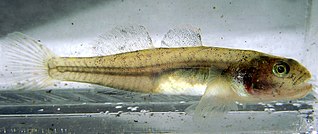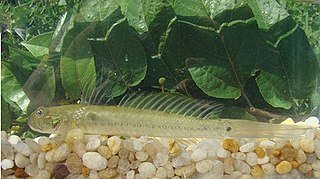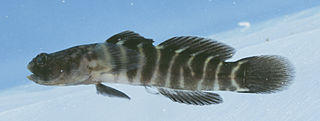
Carl Henry Eigenmann was a German-American ichthyologist of the late nineteenth and early twentieth centuries, who, along with his wife Rosa Smith Eigenmann, and his zoology students is credited with identifying and describing for the first time 195 genera containing nearly 600 species of fishes of North America and South America. Especially notable among his published papers are his studies of the freshwater fishes of South America, the evolution and systematics of South American fishes, and for his analysis of degenerative evolution based on his studies of blind cave fishes found in parts of North America and in Cuba. His most notable works are The American Characidae (1917–1929) and A revision of the South American Nematognathi or cat-fishes (1890), in addition to numerous published papers such as "Cave Vertebrates of North America, a study of degenerative evolution" (1909) and "The fresh-water fishes of Patagonia and an examination of the Archiplata-Archelenis theory" (1909).

Rosa Smith Eigenmann was an American ichthyologist, as well as a writer, editor, former curator at the California Academy of Sciences, and the first librarian of the San Diego Society of Natural History. She "is considered the first woman ichthyologist in the United States." Eigenmann was also the first woman to become president of Indiana University's chapter of Sigma Xi, an honorary science society. She authored twelve published papers of her own between 1880 and 1893, and collaborated with her husband, Carl H. Eigenmann, as "Eigenmann & Eigenmann" on twenty-five additional works between 1888 and 1893. Together, they are credited with describing about 150 species of fishes.

Eucyclogobius newberryi, the northern tidewater goby, is a species of goby native to lagoons of streams, marshes, and creeks along the coast of California, United States. The northern tidewater goby is one of six native goby species of California. It is protected under the Endangered Species Act as an endangered species of the United States since 1994.

Gobius is a genus of fish in the family Gobiidae native to fresh, brackish and marine waters of and around Europe, Africa and Asia. It contains the typical gobies, being the type genus of the formerly recognised subfamily Gobiinae and family and the namesake genus of its order Gobiiformes.

Neogobius is a genus of gobies, native to Black Sea and the Caspian Sea basins. It is part of the broader Benthophilinae subfamily which is also endemic to the same region. Nevertheless, two Neogobius species have recently turned out to be highly invasive and spread across Europe and even to the Great Lakes of North America.

Elacatinus is a genus of small marine gobies, often known collectively as the neon gobies. Although only one species, E. oceanops, is technically the "neon goby", because of their similar appearance, other members of the genus are generally labeled neon gobies, as well. Except for a single East Pacific species, all reside in warmer parts of the West Atlantic, including the Caribbean and Gulf of Mexico. They are known for engaging in symbiosis with other marine creatures by providing them cleaning service that consists of getting rid of ectoparasites on their bodies. In return, Elacatinus species obtain their primary source of food, ectoparasites.

The Gobiiformes are an order of fish that includes the gobies and their relatives. The order, which was previously considered a suborder of Perciformes, is made up of about 2,211 species that are divided between seven families. Phylogenetic relationships of the Gobiiformes have been elucidated using molecular data. Gobiiforms are primarily small species that live in marine water, but roughly 10% of these species inhabit fresh water. This order is composed chiefly of benthic or burrowing species; like many other benthic fishes, most gobiiforms do not have a gas bladder or any other means of controlling their buoyancy in water, so they must spend most of their time on or near the bottom. Gobiiformes means "goby-like".

The Gobionellinae are a subfamily of fish which was formerly classified in the family Gobiidae, the gobies, but the 5th Edition of Fishes of the World classifies the subfamily as part of the family Oxudercidae. Members of Gobionellinae mostly inhabit estuarine and freshwater habitats; the main exception is the genus Gnatholepis, which live with corals in marine environments. The subfamily is distributed in tropical and temperate regions around the world with the exception of the northeastern Atlantic Ocean, the Mediterranean Sea, and the Ponto-Caspian region. It includes around 370 species and 55 genera: Wikipedia articles about genera list about 389 species.

Rhinogobiops is a genus of true gobies in the family Gobiidae. It is monotypic, being represented by the single species, Rhinogobiops nicholsii, also known as the blackeye goby, bluespot goby, and crested goby. They are common inhabitants of coral reefs and rocky habitats along the eastern Pacific Ocean coasts of Mexico, the United States, and Canada, although they are hardly noticed, as they often rest motionless near their shelters.

The blind goby is a species of fish in the goby family Oxudercidae, the only species in the genus Typhlogobius. It is native to the coastlines of southern California in the United States and Baja California in Mexico, where it commonly inhabits the burrows of shrimp of the genus Callianassa. The adult of the species is completely blind and lacks pigmentation, while the juvenile has rudimentary eyes that help it find the shrimp burrows. This species can reach a length of 8.3 centimetres (3.3 in) TL.

Lethops connectens, the halfblind goby, is a species of marine goby native to the eastern Pacific Ocean from central California, United States to Baja California, Mexico where they inhabit kelp forests. The adults hide amongst the stones and the holdfasts of kelp on the seabed while the juveniles form schools in the kelp canopy. This species can reach a length of 6.4 centimetres (2.5 in) TL. Like the name suggests, the eyes of L. connectens are highly reduced. This species is the only known member of its genus.
Chriolepis is a genus of gobies native to the Atlantic and Pacific coasts of the Americas.

The arrow goby is a species of goby native to marine and brackish waters of the Pacific coast of North America from British Columbia to Baja California. This species grows to a length of 6.4 centimetres (2.5 in) SL, though most do not exceed 4.2 centimetres (1.7 in) TL. This fish can also be found displayed in public aquaria. This species is the only known member of its genus.

Ctenogobius is a genus of gobies with a wide distribution in fresh, brackish and marine waters.

Gobionellus is a genus of gobies native to fresh, marine and brackish waters along the Atlantic and Pacific coasts of the Americas.

Gobiosoma is a genus of gobies native to fresh, brackish and marine waters of the Americas.
Parrella is a genus of gobies native to the tropical waters of the Pacific and Atlantic coasts of the Americas. The name of this genus honours the Norwegian American marine biologist, zoologist and oceanographer Albert Eide Parr (1900-1991).

Sicydium is a genus of gobies native to fast-flowing streams and rivers of the Americas with a couple species native to Middle Africa.
Zaniolepis frenata, also known as the shortspine combfish, is a species of ray-finned fish belonging to the family Zaniolepididae.The species occurs in the eastern Pacific Ocean.

Iguanodectidae is a family of freshwater fish in the order Characiformes that lives in South America. It is home to the subfamily Iguanodectinae and the monotypic Bryconops clade. Several species in the family, such as the green line lizard tetra, the tailspot tetra, and the orangefin tetra, are sometimes taken as aquarium fish.
















